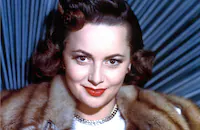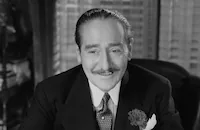The Ambassador's Daughter

Brief Synopsis
Cast & Crew
Norman Krasna
Olivia De Havilland
John Forsythe
Myrna Loy
Adolphe Menjou
Tommy Noonan
Film Details
Technical Specs

Synopsis
Senator Jonathan Cartwright and his wife arrive at the American embassy in Paris, France, on a mission to make that city off-limits to American enlisted men. Ambassador William Fiske and his daughter Joan welcome their guests but are opposed to the idea. While Joan gives Mrs. Cartwright a tour of the city and introduces her to her fiancé, Prince Nicholas Obelski, Fiske receives another visitor, Gen. Andy Harvey, whom he hopes to enlist in opposing Cartwright's plan. Later that day, enlisted men Daniel Sullivan and Albert O'Connor use their wits to get into a benefit fashion show at Christian Dior, the proceeds of which will be donated to the Red Cross. Danny and Al are seated near Obelski, Fiske, Harvey and the Cartwrights, all of whom observe the soldiers' uncouth behavior. When the soldiers flirt with Joan, who is working as a model in the show, she pretends to be French and warns them that the general is nearby. The soldiers decide to leave but complain about their expensive bill. To avoid reinforcing Cartwright's case against American soldiers, Joan intervenes and escorts Danny and Al outside. Afterward she explains to her guests that the soldiers were unaware there was a cover charge, and she and her father pay their bill. When Danny slips back in to ask her on a date, Joan decides to go out with him in order to prove Cartwright wrong, as he had wagered that she would slap the soldier within thirty minutes of a date with him. Although her father and Nicholas disapprove, Mrs. Cartwright playfully poses as Joan's employer and, after meeting Danny and Al, gives her consent for Joan to go out with Danny. When Danny discovers his wallet is missing outside the Eiffel Tower, he accuses Joan of being a pick pocket. Joan is so angry at his accusation that she drops her fake accent. After Danny finds his wallet in a taxi and demands an explanation, Joan claims that she is working in France without a visa and uses the accent as a cover. By dinner time, Joan has fallen in love with Danny and invites him to join her at the ballet the next night. Although she has an extra ticket, Danny insists that he will buy tickets for both of them. After spending an enjoyable evening at numerous nightclubs with Joan, Danny offers to buy her an airplane ticket home so she can visit her supposedly sick father, as well as Danny when he returns stateside. Joan is touched by his thoughtful gesture and, after his wallet goes missing for real and the maitre d' threatens to have Danny arrested, Joan leaves to get some money. When she returns to the embassy she tells everyone about Danny's kindness. However, Al, who is at the embassy with the others, has drunkenly revealed moments earlier that a common soldier's ruse to "get a woman" is to buy her a fake airplane ticket. Joan is disappointed but not convinced that Danny is a cad, so she decides to keep their date to meet at Notre Dame the next afternoon. After Fiske calls in a favor to the nightclub owner and arranges for Danny's bill to be paid, the police return his wallet, which has been found. The next day, Danny buys tickets to the ballet as well as an airplane ticket for Joan, then goes to Christian Dior in hopes of seeing her. Joan is not among any of the models, but arrives with Cartwright, who wants to buy his wife a gift. When Danny sees Joan alone with the older man and overhears her sweet-talking him into purchasing a dress, he assumes the worst about her. As a result, when they meet later, he takes her to a restaurant near her hotel and makes several suggestive remarks. After spilling wine on Joan's dress, another apparent ruse that Al had warned her about, Joan and Danny trade insults and she leaves. When Joan, now thoroughly disappointed, returns to the embassy and admits defeat, Mrs. Cartwright suspects that she has fallen in love. Al, meanwhile, returns to the hotel room he shares with Danny but has been sworn to secrecy about Joan's ruse by Harvey. The next evening, Al takes Danny to the ballet and, through his binoculars, sees Joan and the group in their box seats. During the performance, Danny tells Al about seeing Joan at Dior with an older man, and Al realizes this explains his friend's mistreatment of Joan the night before. Al then secretly goes to the embassy box and tells everyone what happened. At intermission, Danny refuses to acknowledge Joan when he sees her with Cartwright. Mrs. Cartwright stays in the lobby during the second act and, maintaining the guise of Joan's employer, tells Danny a story about Cartwright to provoke Danny's jealousy and protective instinct. After the performance ends, Danny insists that Joan leave Cartwright, presents her with the airplane ticket, and proposes to her, then takes a swing at Cartwright. Al faints, and Joan, who delightedly accepts Danny's proposal, apologizes to a disappointed Nicholas. When Danny learns the truth about Joan and the group, he rescinds his proposal and leaves. Joan steadfastly insists they will marry and the next day, while Danny is working guard duty and is under orders not to speak, Joan tells him he has no recourse and that they will be married in June. They then kiss, and a wedding soon follows.

Director
Norman Krasna
Cast

Olivia De Havilland

John Forsythe

Myrna Loy

Adolphe Menjou

Tommy Noonan

Francis Lederer

Edward Arnold

Minor Watson
Michel Renault Of The Paris Opera
Claude Bessy
Crew
Agop Arakelian
Andre Bakst
Leon Barsacq
Henri Baum
Carita-alexandre
Maurice Cazeneuve
H. Christine
Jean De Bretagne
Ginette Diamant-berger
Christian Dior
Marc Doelnitz
Roger Dwyre
André Guérin
Wladimir Iwanov
Boris Karabanoff
Michel Kelber
Georges Konyn
Norman Krasna
Norman Krasna
Jacques Metehen
Jack Murray
René Petit
Willy Picard
Vincent Baptiste Scotto
Peter Ilyich Tchaikovsky
Barry Trivers
Denise Tual
Henri Eugene Vantard
Marcel Weiss
Nicolas Wilcke
Albert Willemetz
Daniel Wronecki

Videos
Movie Clip



Hosted Intro
Film Details
Technical Specs

Articles
The Ambassador's Daughter
In The Ambassador's Daughter, De Havilland plays Joan Fisk, who acts as hostess for her father, the American Ambassador to France (Edward Arnold). The visit to Paris of an American senator and his wife (Adolphe Menjou and Myrna Loy) adds comic and romantic complications to Joan's life, including a romance with an American soldier (John Forsythe). One of those complications involves Forsythe believing that Joan is a model for Dior, hence the couture wardrobe. De Havilland, at 39, was still youthful and lovely enough to be credible as a young model. Her glow was not only due to newlywed bliss - during filming, she found out she was pregnant with her second child. In her autobiography, Myrna Loy recalled that it was an unusually cold winter in Paris, but De Havilland endured the sometimes uncomfortable working conditions without complaint, and with only occasional flashes of temperament. The actresses sat with hot water bottles under their Dior outfits while shooting in an unheated church, and had electric heating pads on their laps during makeup sessions, according to Loy.
The Ambassador's Daughter was also memorable for Loy because it marked her transition from star to character actress. She was 51 and had not made a film for three years when the offer came, but she liked the script, and was philosophical about the demotion. "You can't play smart glamour girls forever," she said. After all, she still received star billing, although her role was clearly a supporting one.
Another attraction for Loy was that the role of her husband would be played by her longtime pal, Melvyn Douglas. Both were politically active in liberal causes, and had been friends since they appeared together in Third Finger, Left Hand (1940). Their bond solidified as fellow victims of the communist witch hunt hysteria of the late 1940's. Douglas' politician wife, Helen Gahagan Douglas, was demonized and defeated in a congressional race by Richard Nixon; and Loy was accused by the Hollywood Reporter of being a communist. Loy filed a million dollar lawsuit against the paper, and they eventually printed a retraction. One of the most vociferous anti-communists at the time had been Adolphe Menjou. Loy's then-husband, screenwriter Gene Markey, confronted Menjou. "Now listen, Adolphe, you stop this slander. Myrna's no communist," Markey told him. According to Loy, Menjou replied, "Well, she'll do until a real one comes along."
So Loy was understandably dismayed when Douglas had to withdraw from The Ambassador's Daughter, and was replaced by Menjou. At first, the two old adversaries needled each other about politics, with Loy enjoying the support of co-stars and fellow liberals John Forsythe and Tommy Noonan. But the more time they spent together, the more endearing Loy found Menjou. He "turned out to be a warm, affectionate man," Loy recalled.
The critics welcomed the return of De Havilland to comedy, and the return of Loy to the screen, proclaiming The Ambassador's Daughter "lightweight," but "frothy." With its excellent cast and sumptuous production values, the film offered some of the same fizzy pleasures as fine French champagne. And the charms of Paris never dimmed for De Havilland. In the early 1960's she wrote a breezy memoir of her life in France, called Every Frenchman Has One. Even after her marriage to Galante ended in 1979, she remained in Paris, where she still lives.
Producer/Director/Writer: Norman Krasna
Cinematography: Michel Kelber
Editor: Roger Dwyre
Costume Design: Christian Dior
Art Direction: Andre Bakst, Leon Barsacq
Music: Jacques Metehen
Cast: Olivia de Havilland (Joan Fisk), John Forsythe (Danny), Myrna Loy (Mrs. Cartwright), Adolphe Menjou (Senator Cartwright), Tommy Noonan (Al), Francis Lederer (Prince Nicholas Obelski), Edward Arnold (Ambassador Fisk), Minor Watson (General Harvey).
C-103m. Letterboxed.
by Margarita Landazuri

The Ambassador's Daughter
Quotes
Trivia
Notes
The working title of this film was Speak to Me of Love. Norman Krasna's credit appears onscreen as "Written, Produced and Directed by Norman Krasna." Screen credits for the Swan Lake ballet sequence read as follows: "'Swan Lake' Ballet Danced by Michel Renault of the Paris Opera, with Claude Bessy." According to 1951 Los Angeles Times pre-production news items, Speak To Me of Love was originally conceived as an "episodic history of love" to be combined in six segments for a feature-length film. Krasna and Jerry Wald, who were then production associates at Columbia, were considering Shelley Winters and Farley Granger for one sequence, as well as Curtis Bernhardt, Fritz Lang, Nicholas Ray and John Brahm to direct four of the episodes. Wald was to produce.
After the new title The Ambassador's Daughter was assigned, an March 18, 1954 Los Angeles Times news item added that Gene Tierney had been considered for the leading role, and designer Jean Louis was set as costume designer. A July 25, 1956 Daily Variety article noted that a scene shot at an actual nightclub and featuring topless dancers was cut from both American and European prints after being deemed "too provocative." The nightclub scene featuring fan dancers did appear in the viewed print, but there was no nudity. The Ambassador's Daughter was shot on location in Paris, France. Although The Ambassador's Daughter is often cited as the final film of longtime character Edward Arnold, Miami Exposé, which was shot after The Ambassador's Daughter, actually marked his final performance. Arnold died on April 26, 1956, shortly after completing his role in Miami Exposé (see below).

Miscellaneous Notes
Released in United States Fall September 1956
CinemaScope
Released in United States Fall September 1956














